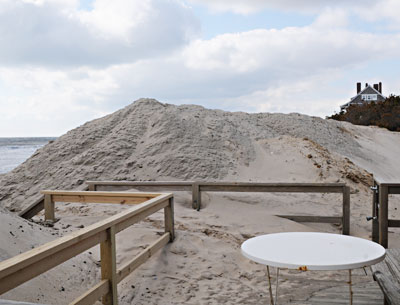Trustee Sand In Demand In Montauk

Pressure to rebuild Montauk’s downtown beaches is so great that East Hampton Town’s coastal erosion committee floated the idea last week of exporting sand to the hamlet from other parts of town. The committee’s priority, said its chairman, Drew Bennett, is to find a way to protect Montauk’s downtown business district which, with its protective dunes eroded, has been left vulnerable to storm surge. The committee was formed by the town board after Hurricane Sandy and charged with coming up with ways to deal with the dangers posed by recurrent storms. “The plan,” Mr. Bennett said, was for the committee to keep the federal government’s feet to the fire after Congress promised a reported $3.4 billion to the Army Corps of Engineers to help protect the coast from future storms. Mining sand from offshore deposits is one way this might be done. A report on progress in the effort to attract a portion of the federal money will be presented at the committee’s next meeting, Tuesday, 3 p.m. at Town Hall. The federal money is reportedly contingent on an equal amount of spending cuts in the federal budget. Mr. Bennett said the discussion about local sand deposits and how they might help Montauk came about as an interim fix before any long-range federally funded project could be brought to bear. Not so fast, said Diane McNally, the East Hampton Town Trustees’ presiding officer, who attended the meeting. Ms. McNally said Tuesday that she recognized downtown Montauk’s dire straits, but the idea of taking sand from trustee-controlled beaches and/or water bodies to rebuild beaches in Montauk where the trustees lost authority in the 19th century posed jurisdictional problems. And, she said it could shortchange ocean and bayfront residents in need of sand in the western part of the township. By virtue of a 17th-century patent, the trustees own most of the town’s bay bottom and beaches on behalf of the public. This means trustees control the people’s sand except in Montauk, where they lost sway. Most of the ocean beaches in Montauk are also public, but are under the control of the town board, not the trustees. The beaches are in separate jurisdictions, and, in this case their stewards may have separate priorities. Ms. McNally said the idea of shipping sand east from deposits in Georgica Pond and Three Mile, Accabonac, and Northwest Harbors was broached at the meeting, but not fully explored. She sees problems. “They want trustee sand in Montauk? There was a time we couldn’t sneeze beyond East Hampton,” she said, alluding to the often-contrary relationship between the trustees and the town board over jurisdiction. “What about the person at Lazy Point who lost a dune? Not everyone cares about Montauk. We have to look at the trustees’ own beaches.” Ms. McNally said the real challenge lay in getting the State Department of Environmental Conservation to liberalize its policies involving the mining and dispersal of sand. Currently, the agency allows only 12,000 cubic yards of sand to be removed each year from a large shoal at the southern end of Georgica Pond, a drop in the bucket for beachfront residents who hire contractors to rebuild beaches and dunes to protect their houses. A 10-year permit to excavate sand from Georgica Pond will expire on March 14. “So, we will be talking to them about renewing the permit and possibly for more sand. We’re going to ask,” Ms. McNally said. She said current D.E.C. policy also had restrictions on where excavated sand can be taken. “They don’t leave it to the trustees. They tell us where to put it.” Sand is supposed to stay within the same littoral area from which it was taken. As it stands, sand excavated from Georgica Pond cannot be trucked to an eroded beach on the bayside of East Hampton, for example. The trustee clerk said the town’s coastal policies as well as the state’s needed to be revisited. “When the L.W.R.P. [Local Waterfront Revitalization Program] was created it was done scientifically with no emotion,” she said referring to the omnibus, state-authorized plan to manage coastal protections in East Hampton. It was approved by the State Department of State and became town policy in December of 2007. “Now, with all the storms, there’s emotion,” Ms. McNally said. The threat is no longer theoretical, she said. “The L.W.R.P. is black and white. Perhaps there are some gray areas.” For instance, Ms. McNally said the L.W.R.P. considered sandbags and geocubes (bigger cube-shaped, fabric containers filled with sand) hard structures, and only permitted them on an emergency and temporary business. “What if the plan could be developed so they could go in before winter storms, then taken out in the spring? Not detrimental in the long run. ‘Temporary’ would mean seasonally,” Ms. McNally said.
